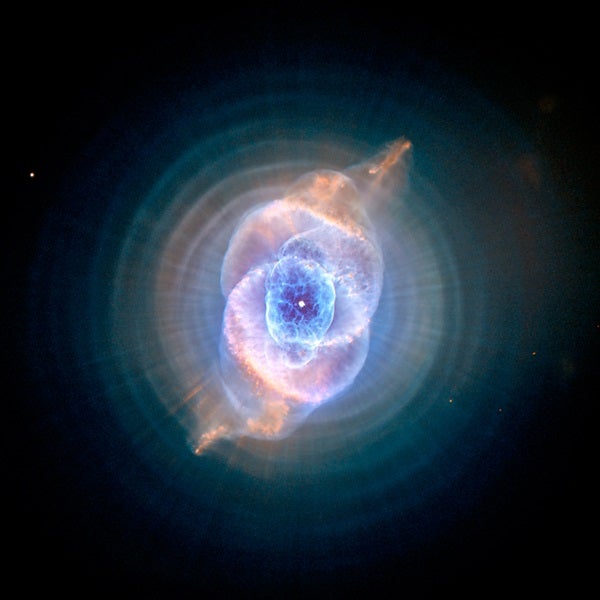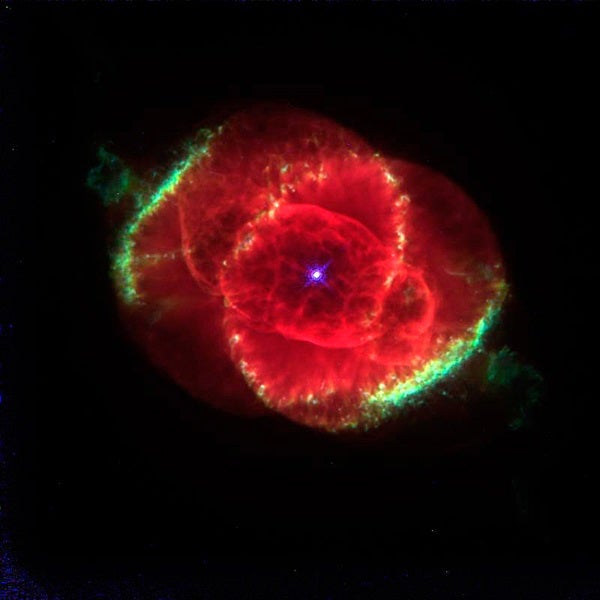When astronomer William Herschel found a small blue-green blob in the constellation Draco the Dragon in 1786, it had the color and size of Uranus, which he had famously discovered five years earlier. His notation that it looked like a planet led others to start calling such deep-space objects planetary nebulas.
Bad term. Roughly 80 years later, English amateur astronomer William Huggins examined it using his spectroscope and solved its main mystery “with a single glance,” as he put it later. He saw that it was made exclusively of glowing gas; it resembled a planet no more than his wife resembled then-president Lincoln. The sky was peppered with other similarly small, expanding gassy blobs, many of them round and empty in the middle like doughnuts. They each housed a peculiar star in the exact center.

Bringing the universe to your door. We’re excited to announce Astronomy magazine’s new Space and Beyond subscription box – a quarterly adventure, curated with an astronomy-themed collection in every box. Learn More >>
These days, backyard astronomers adore such planetary nebulae, as we still unfortunately call them. By and large, they are not mysterious. In all cases, a Sun-like star has just completed its obligatory red giant phase of old age and then puffed out a bubble of its outer layers. While this expands, the hot central star heads the opposite way and shrinks toward its eventual white dwarf destiny.
Such bubble-like puffs of star material remain visible for roughly 10,000 years before they spread out and dilute into invisibility. That’s just a quick “achoo” in star time, and such ultra-brief events should therefore be rarely observed. Yet, instead, planetary nebulae are all around us, as common as roaches in Rio. Some 5,000 have been cataloged just in our own galaxy. This means that being extremely common must offset their brief lifespans.
Common is not what earns a place in this book, however, which is why so many other intriguing rings and bubbles are absent from these pages. They’re lovely, but their mechanisms are too well-known to merit the coveted adjective “weird.”
Not this one. Added to the New General Catalogue over a century ago with the easily remembered designation NGC 6543 — but commonly called the Cat’s Eye Nebula because of its green elliptical appearance through backyard telescopes — it is unusual in almost every way.
The weirdness begins with its position in the sky. The Cat’s Eye hovers at the North Ecliptic Pole, the spot exactly 90° from the plane of our solar system. This means a line drawn precisely at right angles from Earth’s orbit around the Sun goes to the Cat’s Eye. This also means NGC 6543 marks the spot around which Earth’s axis wobbles in its 26,000-year precession. A sharp compass needle placed in this nebula (in the crook of the Dragon’s curve), with the pencil part of the compass at the current North Star, Polaris, could scribe a circle tracing the location of every North Star in our planet’s history.
But location is not everything. With better telescopes — and various techniques like false-color and infrared imagery — NGC 6543 is seen to have a beautiful but baffling complex structure of intersecting ovals and spirals. The architecture’s intricacy may be partially explained if this ejected matter comes from a binary central star instead of the normal single one, but this doesn’t fully work. Moreover, the outside of the Cat’s Eye presents a series of odd, faint concentric rings. Their perfectly even spacing makes astronomers conclude that, before the central star’s planetary nebula erupted a mere 1,000 years ago, it emitted burps that must have created spherical shells at regular intervals. Theory cannot explain such an evenly timed choreography of eruptions, like backfires on an engine trying to start, and yet there they are. (For a new interpretation, see the Carbon Spiral, number 6 on our list.)
The central star’s surface is 150,000° Fahrenheit (around 80,000° Celsius), which makes our Sun’s 11,000° F (6,100° C) seem comparatively like a feeble candle. The star’s sizzling heat makes it emit a fierce stellar wind, blowing off and leaking away its own outer layers at the rate of 20 trillion tons a second. At a speed of 1,000 miles (1,600 kilometers) per second, this material slams into the bubbles of gas it previously expelled. This sand-blasting spray is hollowing out the neighborhood immediately around the star and explains the emptiness there.
But alas, not much else makes sense.
Intense high-energy X-rays pour from the central star despite the fact that its hot temperature should be insufficiently ferocious to justify such an X-ray stream. Something else must be creating them, but what? And why is that inner ellipse surrounded by those concentric bubbles of material, seemingly emitted at short one-century intervals, which is incompatible with our theories? And, most crazy of all, this inner structure is nested inside two enormous spherical bubbles, each 0.25 light-year across and oddly conjoined and bewilderingly offset from the center. This overlapping double-bubble is both NGC 6543’s dominant feature and its dominant puzzle.
As Nobel physicist Isidor Rabi once famously said: “Who ordered that?”











